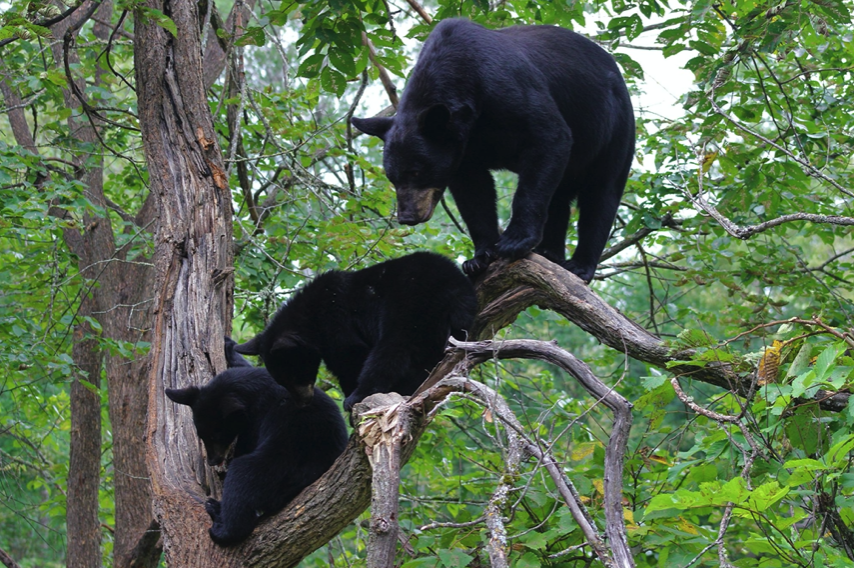Editor’s note: The following story was originally published by FAO in June of 2022. Recently, at least two community members have posted photos and a video on Facebook, each documenting a sighting of a black bear in Jefferson County, most recently near Hebron. According to information released in 2022 by the Wisconsin DNR, bear sightings in southern Wisconsin remain rare, however sightings in 2022 in Waukesha and Washington counties serve as a reminder that bears can be found in any county. The story includes tips offered to Wisconsin residents about how to co-exist with bears. The full story published in 2022 follows.
DNR: Black bear sightings increase in summer; populations expanding south over last decade
Following several recent black bear sightings across the state, the Wisconsin Department of Natural Resources (DNR) is reminding the public to take precautions to avoid potential conflicts this summer, according to information released Friday (June 17, 2022) by the department.
Although black bears are most common in the northern half of the state, populations have been slowly expanding south over the last decade. Wisconsinites are encouraged to take the same bear precautions no matter what part of the state, the release stated.
While bear sightings in southern Wisconsin remain rare, sightings in Waukesha and Washington counties are a reminder that bears can be found in any county, the release noted.
Although not included in the DNR news release, according to information found on a Facebook page titled: “Walworth County Scanner Updates,” black bears have been spotted, as reported by commenters on the site, near Whitewater and Elkhorn.
On June 17, a comment on the page read: “from our inbox, Just saw a black bear in Elkhorn.”
On May 29, the Facebook page reported: “Cty P right before Bluff Creek small black bear in the road,” followed by, “From reader: I was the one who called it in, was a full sized black bear. Almost hit it in the road on my way home from work.”
The DNR release continued: Sightings usually increase in early summer when young bears strike out on their own for the first time. Bear breeding season also occurs in early summer resulting in many male bears wandering around in search of a mate.
If a bear is near your home or cabin:
- From a safe location, wave your arms and make noise to scare it away.
- Back away slowly and seek a safe location where you can wait for the bear to leave.
- When scaring a bear away, make sure it has a clear escape route; never corner a bear.
- If you encounter a bear while in the woods, DO NOT RUN, stay calm and do not approach the bear.
- Never approach any bear.
- For your safety, do not attempt to break up a fight between your pet and a bear.
Black bears are naturally cautious animals that normally avoid contact with people for their safety, but conflicts between people and bears can arise. Additionally, bears can quickly learn to associate humans with food when food sources are available.
If a bear finds food, such as bird feed or garbage near your home or cabin, it will likely return for more. Bear visits are more likely to stop when food is no longer available. Bears will periodically check sites where food was once available, so it may take several days to weeks after a food source has been removed for a bear to completely discontinue visiting food sites.
It is important to make sure these tasty food sources are hidden from bears at all times of the year, but it’s especially important in warmer months when bears are more active.
Follow these steps to avoid attracting black bears:
- Do not knowingly feed a bear.
- Completely remove bird feeders, even during daytime hours – Bears are active during the day and may cause problems even if the feeders are out only during that time.
- Clean areas where bird feeders were located so that accumulated deposits of spilled seed are removed.
- Reduce garbage odors by rinsing food cans before putting them in covered recycling containers or garbage cans.
- Keep meat scraps in the freezer until garbage day, and if possible, keep garbage cans in a closed building until the morning of pickup.
- Be sure to lock commercial dumpsters.
- Keep pet food inside or inaccessible to bears even during daytime hours.
- Keep grills and picnic tables clean.
Bears are normally solitary forest animals, but their powerful sense of smell can lead them into urban areas in search of food. Black bears are secretive animals and usually try to avoid people. However, conflicts with humans can occur when bears destroy gardens, bird feeders, apiaries and trash cans.
By understanding bear behavior, there are several ways people can reduce negative human-bear conflicts around their homes. The DNR’s Living With Black Bears In Wisconsin pamphlet is a great resource for learning more about co-existing with bears in Wisconsin.
The department partners with the U.S. Department of Agriculture’s Wildlife Services Program to respond to approximately 800 bear-related complaints reported in Wisconsin each year.
If unable to resolve a conflict with a bear, contact the USDA Wildlife Services toll-free line at 1-800-433-0663 for properties in Southern Wisconsin and 1-800-228-1368 for properties in Northern Wisconsin. Most complaints are resolved through technical advice.
More information regarding bears and safety is available on the DNR’s Bear Hunting webpage.

Black bears, photo courtesy of the U.S. Fish and Wildlife Service.
This post has already been read 37754 times!